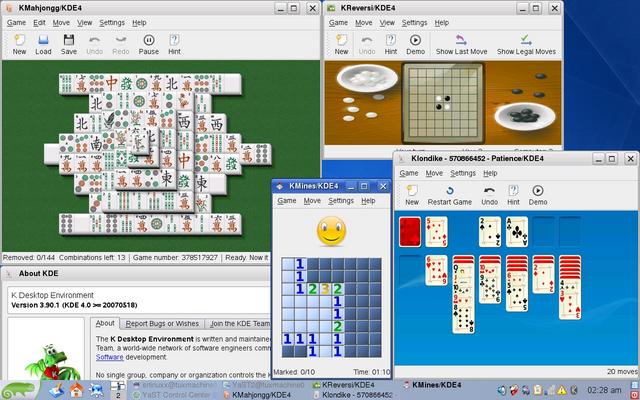OpenSUSE 10.3 Alpha 5 report



Alpha 5 in the OpenSUSE 10.3 developmental cycle was released several days ago and with it came a few surprises. As opposed to big changes in the installed system itself, the big news this release was the 1 CD install offerings.
 In KDE and GNOME flavors, this release brought the single ~700MB install cdrom. I found them to be complete enough to get a stable desktop system. Not much development will be possible without further package installation, but downloading and installing the required and other desired packages through yast might be preferrable to downloading the usual 5 or 6 cds or the huge dvd.
In KDE and GNOME flavors, this release brought the single ~700MB install cdrom. I found them to be complete enough to get a stable desktop system. Not much development will be possible without further package installation, but downloading and installing the required and other desired packages through yast might be preferrable to downloading the usual 5 or 6 cds or the huge dvd.
The only quirk I saw with installation of the one cd installs was the offering of XGL in the patterns of package selection and then receiving a error when trying to "check" it. The error stated those packages weren't available. As XGL is a completely new entry, listed as "Desktop Effects" in the traditional install media, it leads me to think they are in the process of spliting those packages into small enough components to fit on the one cd installers.
In essence, as one might imagine, those 1 cd install disks contain just what is absolutely is necessary. There's a KDE 1 cd install package list Here, and Gnome's Here.
Again, as with the last release, Instlux wasn't able to get very far into the install onto the Windows partition. In fact, it exited with the same exact "Cannot copy E:\boot\x86_64\loader\intrid to C:\openSUSE\initrd" error. Well, I guess it needs more work.
Another new development is the use of libata, which will name devices in the /dev/sdXx format. So I guess my earlier assumption wasn't really too misplaced afterall. Updating from a previous install is supposed to fix all the files necessary in order for this change to go virtually unnoticed by end users, or at least give them no problems. I attempted to test on two installs, one version 10.2 and the other 10.3 Alpha 3. With 10.2, the package selection summary had a warning stating that upgrading from 10.2 to 10.3 isn't compatible. Furthering attempts, I then got several unresolved and locked files conflicts. I had customized that install trying to fix fonts, enable multimedia playback, and such so we can't really put all the blame on OpenSUSE. My other install was pretty much default and that upgrade process didn't fair much better. After warning me that libata doesn't support partition numbers beyond 15, configuration was fairly textbook. Then it spent quite a bit of time working away upgrading without issue, but ultimately shot an error about not being able to create the initrd image. So alas, the only real success I had was with a fresh install.
KDE4 is slowly creeping into OpenSUSE. Some of the directories are filled out and contain quite a few libraries and supporting files. There are even a few KDE4 binaries present - mostly in the form of games. In fact Kmahjongg, Kreversi, Kmines, and Patience have made it into the menu. There are several other KDE4 apps that are not installed by default but are listed in package manager.

Some RPM versioning this release:
- kernel-default-2.6.22_rc4_git3-2
- xorg-x11-7.2-83
- gcc-4.1.3-52
- qt3-3.3.8-41
- gtk2-2.10.11-23
- glibc-2.6-5
- kdebase3-3.5.7.15
- gnome-desktop-2.18.1-32
- OpenOffice_org-2.2-13
- MozillaFirefox-2.0.0.4-6
- gimp-2.2.13-83
- ndiswrapper-1.46-5
- wpa_supplicant-0.5.7-33
- Full List
Some Changelog Highlights include:
++++ gaim-otr:
- replace gaim-devel by pidgin-devel in buildreq
- add pidgin patch (diff from pidgin-otr-3.0.0)
++++ kernel-default:
- Enable CONFIG_REISERFS_CHECK.
- Update to 2.6.22-rc4-git3
++++ dockutils:
- add 24dock hook to add to pm-utils sleep hooks on installation
- add support for Thinkpad X40 dock station
- figure out scsi hosts manually
++++ kdenetwork3:
- Fix pwc based webcams, eg Quickcams
- Fix toolbar setting changes don't persist
++++ powertop:
- Update to PowerTOP 1.6
++++ beagle-index:
- Use pidgin instead of gaim.
++++ kdebase4:
- update to 3.90.1.svn670093
++++ koffice:
- update to 1.6.3
++++ MozillaThunderbird:
- Security update to version 1.5.0.12
++++ Lots of package renames and splits to create smaller systems
++++ Full Changelog for Alpha 5
Most annoying bugs:
- YaST do not accept the default gpg key by default and asks for import during registration.
- grub config completely broken on update
- the kernel is updated, meaning a new one appears and a old one
disappears, but:- the old entries for the kernel no longer in the system stay in menu.lst
- the entry pointing to the old kernel is the default boot entry
- the newly added boot entries have "root (/dev/sda3)" instead of "root (hd0,2)" for example, grub will
never find that device ... - manually added kernel options are removed on update
- the kernel is updated, meaning a new one appears and a old one
- No remote repository gets added during installation
- ifup/getcfg are broken, so the traditional network scripts will not work
- No NIS offered during installation
- Win keys are hard binded to GNOME menu
- X.org doesn't start when using one CD installation media on some laptops
- X.org's RADEON Xserver may crash when going to powersave mode
Between the release of 1 CD installs and the appearance of KDE4, it's been a fairly exciting release this time. No apparent new eye candy yet, but updated desktops and applications abound. I did a lot of testing this time and found that the 1 CD installs work okay as well as fresh install of the traditional media, but the upgrade path is still a bit buggy as is the install-on-Windows. We can expect Alpha6 around Thu, Jul 19 and it will feature gcc 4.2.
-

- Login or register to post comments
 Printer-friendly version
Printer-friendly version- 33785 reads
 PDF version
PDF version
More in Tux Machines
- Highlights
- Front Page
- Latest Headlines
- Archive
- Recent comments
- All-Time Popular Stories
- Hot Topics
- New Members
digiKam 7.7.0 is released
After three months of active maintenance and another bug triage, the digiKam team is proud to present version 7.7.0 of its open source digital photo manager. See below the list of most important features coming with this release.
|
Dilution and Misuse of the "Linux" Brand
|
Samsung, Red Hat to Work on Linux Drivers for Future Tech
The metaverse is expected to uproot system design as we know it, and Samsung is one of many hardware vendors re-imagining data center infrastructure in preparation for a parallel 3D world.
Samsung is working on new memory technologies that provide faster bandwidth inside hardware for data to travel between CPUs, storage and other computing resources. The company also announced it was partnering with Red Hat to ensure these technologies have Linux compatibility.
|
today's howtos
|









.svg_.png)
 Content (where original) is available under CC-BY-SA, copyrighted by original author/s.
Content (where original) is available under CC-BY-SA, copyrighted by original author/s.

instlux issues
Hi,
the issue with instlux is known and should be actually fixed for Alpha5. But unfortunately the new version of instlux did make it on the media in time.
See:
https://bugzilla.novell.com/show_bug.cgi?id=275571
Attached on the bugzilla entry you could found a fixed version of instlux for testing...
instlux issues
instlux actually worked quite well for me in Alpha 5, at least in beginning the install. There are two things that I would try to fix before the final release, though.
When dual-booting (which I imagine many, if not most, users will be doing), after selecting Windows in Grub, you get the Windows boot menu (at least in Win2K) asking whether you want to boot Windows or the openSUSE install. This will confuse some folks, and is just an extra click that we don't really need.
When Windows 2K appears, a box asks you if you want to remove the "missing" openSUSE install program. Assuming there's a good reason for the box to appear at all, it would be good to add some language that you're just deleting the install program -- not openSUSE! Newbies get frightened easily.
FWIW, I blogged my Alpha 5 install experience:
http://metaverse.wordpress.com/2007/06/23/installing-opensuse-103-alpha-5/
http://metaverse.wordpress.com/2007/06/23/alpha-5-install-continued/
Re: instlux issues
When dual-booting (which I imagine many, if not most, users will be doing), after selecting Windows in Grub, you get the Windows boot menu (at least in Win2K) asking whether you want to boot Windows or the openSUSE install. This will confuse some folks, and is just an extra click that we don't really need.
Actually the "openSUSE installer" entry should disappear if you run the uninstaller of the "openSUSE installer". This actually the task of the uninstaller application which is placed in the autostart.
But i guess we should give a final hint about that confusing issue before the installer finishes and the installer reboots the machine.
Thanks for the hint...
When Windows 2K appears, a box asks you if you want to remove the "missing" openSUSE install program. Assuming there's a good reason for the box to appear at all, it would be good to add some language that you're just deleting the install program -- not openSUSE! Newbies get frightened easily.
As mentioned before the "openSUSE installer" entry in the Windows boot menu will bother you at least tow times. First time if you start the installer .. second time if you reboot into windows after installation. The entry is written in the windows boot menu - until you reboot the first time back to windows and the "openSUSE installer" uninstaller got successfully executed.
FWIW, I blogged my Alpha 5 install experience:
http://metaverse.wordpress.com/2007/06/23/installing-opensuse-103-alpha-5/
http://metaverse.wordpress.com/2007/06/23/alpha-5-install-continued/
Thanks for your feedback - will have a look to your review.
Btw. the "openSUSE uninstall" name confusion should be fixed with the latest version as well. But again - unfortunately the installer didn't made it on the openSUSE 10.3 Alpha5 media in time. The netinstaller should be affected by all those issue... only the hint about that the "openSUSE installer" entry will disappear after executing the "openSUSE installer - uninstaller" (terrible name).
best regards,
Daniel